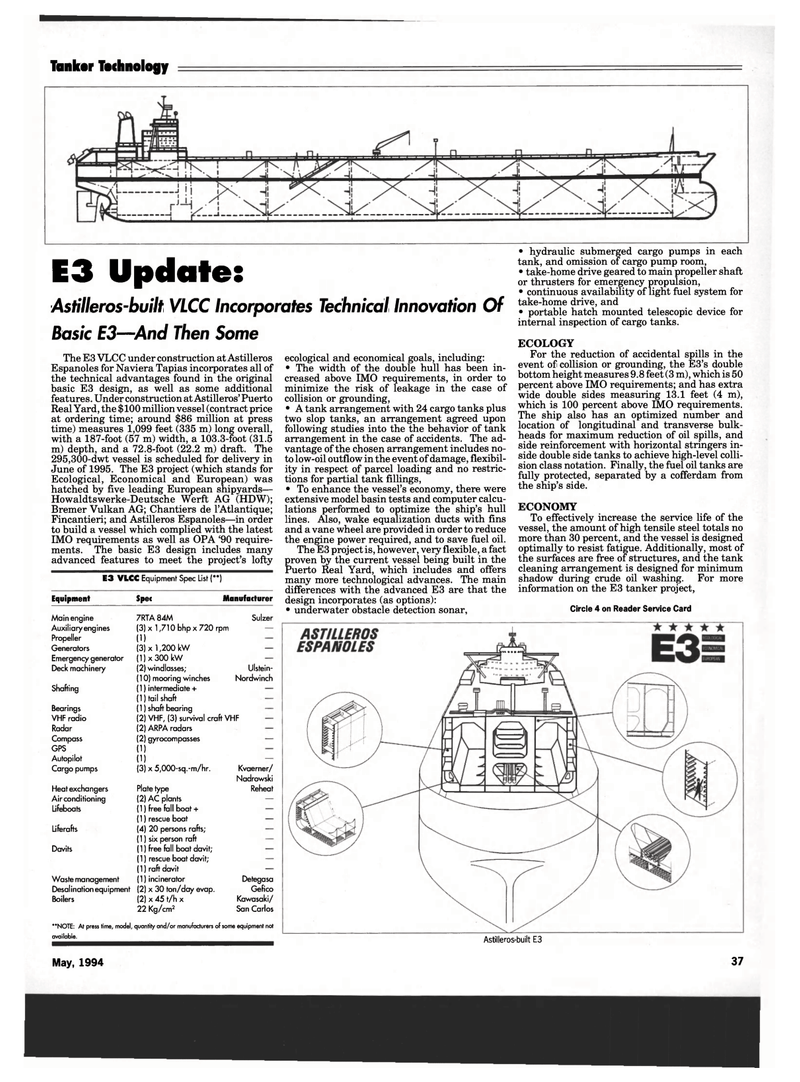
Page 35: of Maritime Reporter Magazine (May 1994)
Read this page in Pdf, Flash or Html5 edition of May 1994 Maritime Reporter Magazine
Tanker Technology
E3 Update:
Astilleros-built VLCC Incorporates Technical Innovation Of
Basic E3—And Then Some
The E3 VLCC under construction at Astilleros
Espanoles for Naviera Tapias incorporates all of the technical advantages found in the original basic E3 design, as well as some additional features. Under construction at Astilleros' Puerto
Real Yard, the $100 million vessel (contract price at ordering time; around $86 million at press time) measures 1,099 feet (335 m) long overall, with a 187-foot (57 m) width, a 103.3-foot (31.5 m) depth, and a 72.8-foot (22.2 m) draft. The 295,300-dwt vessel is scheduled for delivery in
June of 1995. The E3 project (which stands for
Ecological, Economical and European) was hatched by five leading European shipyards—
Howaldtswerke-Deutsche Werft AG (HDW);
Bremer Vulkan AG; Chantiers de l'Atlantique;
Fincantieri; and Astilleros Espanoles—in order to build a vessel which complied with the latest
IMO requirements as well as OPA '90 require- ments. The basic E3 design includes many advanced features to meet the project's lofty
E3 VLCC Equipment Spec List (**)
Equipment Spec Manufacturer
Main engine
Auxiliary engines
Propeller
Generators
Emergency generator
Deck machinery
Shafting
Bearings
VHF radio
Radar
Compass
GPS
Autopilot
Cargo pumps
Heat exchangers
Air conditioning
Lifeboats
Liferafts
Davits
Waste management
Desalination equipment
Boilers 7RTA 84M (3) x 1,710 bhp x 720 rpm (1) (3) x 1,200 kW (1) x 300 kW (2) windlasses; (10) mooring winches (1) intermediate + (1) tail shaft (1) shaft bearing (2) VHF, (3) survival craft VHF (2) ARPA radars (2) gyrocompasses (1) (1) (3) x 5,000-sq.-m/hr.
Sulzer
Ulstein-
Nordwinch
Plate type (2) AC plants (1) free fall boat + (1) rescue boat (4) 20 persons rafts; (1) six person raft (1) free fall boat davit; (1) rescue boat davit; (1) raft davit (1) incinerator (2) x 30 ton/day evap. (2) x 45 t/h x 22 Kg/cm2 ecological and economical goals, including: • The width of the double hull has been in- creased above IMO requirements, in order to minimize the risk of leakage in the case of collision or grounding, • A tank arrangement with 24 cargo tanks plus two slop tanks, an arrangement agreed upon following studies into the the behavior of tank arrangement in the case of accidents. The ad- vantage of the chosen arrangement includes no- to low-oil outflow in the event of damage, flexibil- ity in respect of parcel loading and no restric- tions for partial tank fillings, • To enhance the vessel's economy, there were extensive model basin tests and computer calcu- lations performed to optimize the ship's hull lines. Also, wake equalization ducts with fins and a vane wheel are provided in order to reduce the engine power required, and to save fuel oil.
The E3 project is, however, very flexible, a fact proven by the current vessel being built in the
Puerto Real Yard, which includes and offers many more technological advances. The main differences with the advanced E3 are that the design incorporates (as options): • underwater obstacle detection sonar, • hydraulic submerged cargo pumps in each tank, and omission of cargo pump room, • take-home drive geared to main propeller shaft or thrusters for emergency propulsion, • continuous availability of light fuel system for take-home drive, and • portable hatch mounted telescopic device for internal inspection of cargo tanks.
ECOLOGY
For the reduction of accidental spills in the event of collision or grounding, the E3's double bottom height measures 9.8 feet (3 m), which is 50 percent above IMO requirements; and has extra wide double sides measuring 13.1 feet (4 m), which is 100 percent above IMO requirements.
The ship also has an optimized number and location of longitudinal and transverse bulk- heads for maximum reduction of oil spills, and side reinforcement with horizontal stringers in- side double side tanks to achieve high-level colli- sion class notation. Finally, the fuel oil tanks are fully protected, separated by a cofferdam from the ship's side.
ECONOMY
To effectively increase the service life of the vessel, the amount of high tensile steel totals no more than 30 percent, and the vessel is designed optimally to resist fatigue. Additionally, most of the surfaces are free of structures, and the tank cleaning arrangement is designed for minimum shadow during crude oil washing. For more information on the E3 tanker project,
Circle 4 on Reader Service Card
Kvaerner/
Nadrowski
Reheat
Detegasa
Gefico
Kawasaki/
San Carlos **NOTE: At press time, model, quantity and/or manufacturers of some equipment not available. Astilleros-built E3
May, 1994 37

 34
34

 36
36
